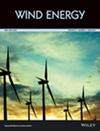Coupling wind LiDAR fixed and volumetric scans for enhanced characterization of wind turbulence and flow three‐dimensionality
IF 3.3
3区 工程技术
Q3 ENERGY & FUELS
引用次数: 0
Abstract
Summary Over the last decades, pulsed light detection and ranging (LiDAR) anemometry has gained growing attention in probing the marine atmospheric boundary layer (MABL) due to its ease of use combined with compelling spatio‐temporal resolution. Among several scanning strategies, fixed scans represent the most prominent choice when high‐frequency resolution is required; however, no information is provided about the spatial heterogeneity of the wind field. On the other hand, volumetric scans allow for the characterization of the spatial variability of the wind field with much lower temporal resolution than fixed scans. In this work, the recently developed “LiDAR Statistical Barnes Objective Analysis” (LiSBOA) algorithm for the optimal design of LiDAR scans and retrieval of wind velocity statistics is tailored for applications in the MABL. The LiDAR data, collected during a recent experimental campaign over Lake Lavon in Texas, show a good consistency of mean velocity profiles between fixed and LiSBOA‐interpolated volumetric data, thus further encouraging the use of coupled fixed and volumetric scans for simultaneous characterizations of wind turbulence statistics along the vertical direction and volumetric heterogeneity of the wind field.耦合风激光雷达固定和体积扫描增强表征的风湍流和流动的三维
在过去的几十年里,脉冲光探测和测距(LiDAR)风速测量由于其易于使用和令人信服的时空分辨率,在探测海洋大气边界层(MABL)方面得到了越来越多的关注。在几种扫描策略中,当需要高频分辨率时,固定扫描是最突出的选择;然而,没有提供关于风场空间异质性的信息。另一方面,体积扫描允许表征风场的空间变异性,其时间分辨率比固定扫描低得多。在这项工作中,最近开发的“激光雷达统计巴恩斯客观分析”(LiSBOA)算法用于优化设计激光雷达扫描和风速统计数据的检索,是为MABL的应用量身定制的。最近在德克萨斯州Lavon湖的实验活动中收集的LiDAR数据显示,固定和LiSBOA插值的体积数据之间的平均速度曲线具有良好的一致性,从而进一步鼓励使用耦合的固定和体积扫描来同时表征沿垂直方向的风湍流统计和风场的体积非均质性。
本文章由计算机程序翻译,如有差异,请以英文原文为准。
求助全文
约1分钟内获得全文
求助全文
来源期刊

Wind Energy
工程技术-工程:机械
CiteScore
9.60
自引率
7.30%
发文量
0
审稿时长
6 months
期刊介绍:
Wind Energy offers a major forum for the reporting of advances in this rapidly developing technology with the goal of realising the world-wide potential to harness clean energy from land-based and offshore wind. The journal aims to reach all those with an interest in this field from academic research, industrial development through to applications, including individual wind turbines and components, wind farms and integration of wind power plants. Contributions across the spectrum of scientific and engineering disciplines concerned with the advancement of wind power capture, conversion, integration and utilisation technologies are essential features of the journal.
 求助内容:
求助内容: 应助结果提醒方式:
应助结果提醒方式:


